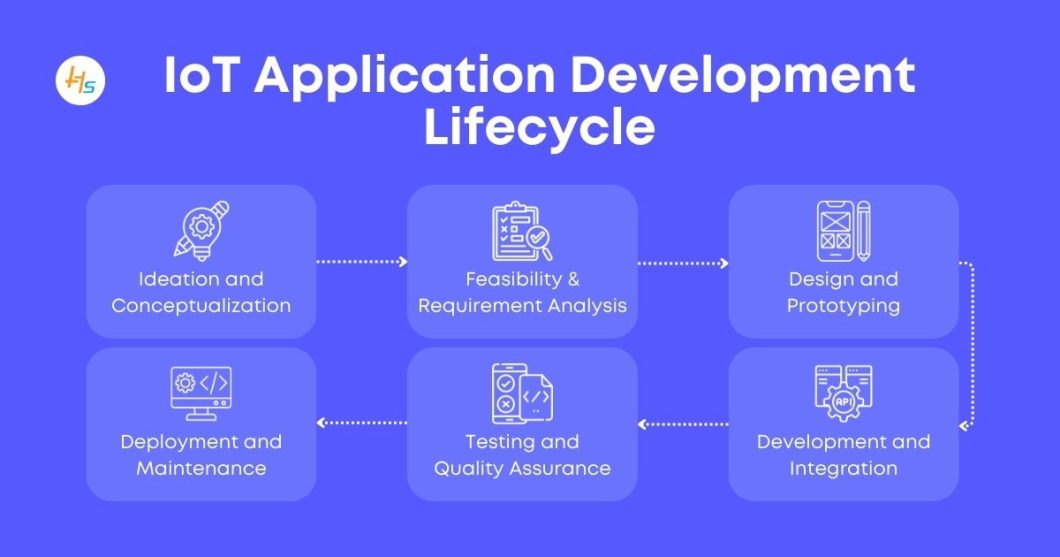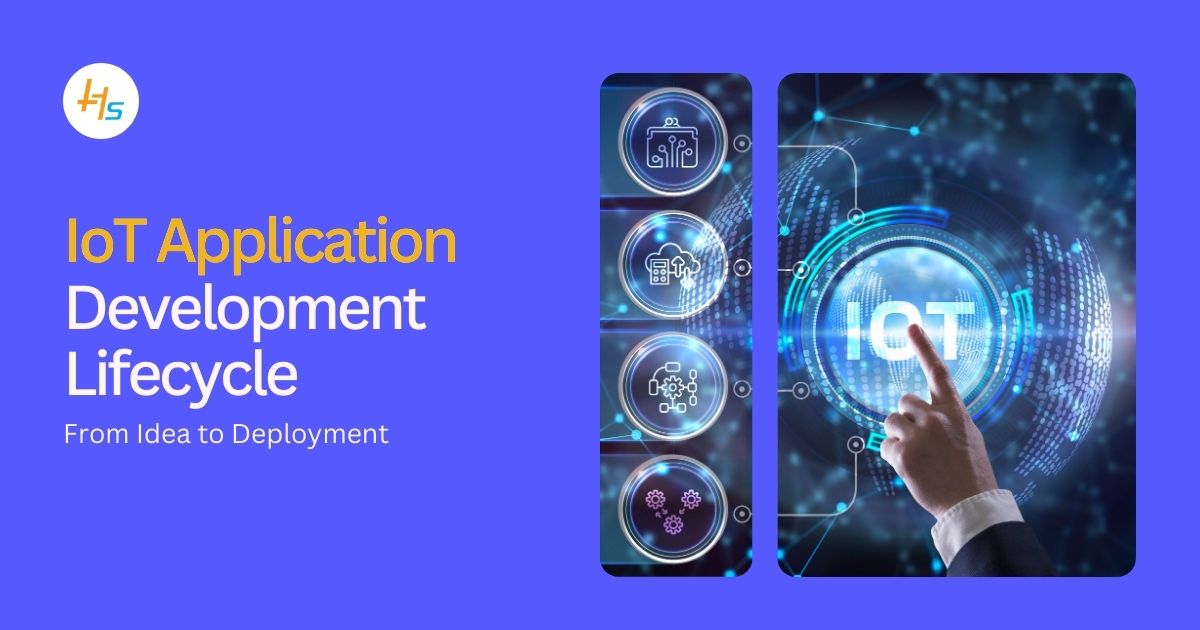The Internet of Things (IoT) is revolutionizing industries and transforming how we live and work. According to Statista, there were 15.14 billion connected IoT devices in use globally in 2023, and this number is expected to grow to 29.42 billion by 2030. As businesses and consumers continue to rely on IoT technology for a range of applications, the development of IoT applications has become a critical component of this transformation. In this article, we will explore the IoT application development lifecycle, from initial ideation to final deployment.
Whether you are a business owner, developer, or part of an IoT Application Development Company, understanding the stages of this lifecycle is crucial for the successful creation and deployment of IoT solutions.
The growth of IoT has created a huge demand for sophisticated IoT applications. IoT applications are used across multiple industries, such as healthcare, smart cities, logistics, and manufacturing, to collect data, enhance operational efficiency, and improve user experience.
IoT applications require a complex integration of devices, networks, and software. Developing such applications involves multiple stages, each of which demands attention to detail and expertise. For businesses looking to bring an IoT product to market, partnering with an IoT Application Development Company or leveraging IoT App development services can significantly ease the process.
Table of Contents
What is IoT Application Development?
IoT application development refers to the creation of software solutions that allow devices to communicate, interact, and exchange data through the internet or a network. These applications can range from simple solutions, such as controlling home appliances remotely, to complex systems used in industries like manufacturing and healthcare.
Key Components of an IoT Application
An IoT application generally consists of the following components:
- Devices: Sensors, actuators, and embedded systems that collect and transmit data.
- Connectivity: Communication technologies (Wi-Fi, Bluetooth, Zigbee, etc.) that allow data transfer between devices.
- Cloud/Edge Infrastructure: A central location to store, process, and analyze data.
- Software: The application that handles data visualization, control, and user interaction.
- Security: Measures to ensure data protection and prevent unauthorized access.
IoT Application Development Lifecycle
The lifecycle of an IoT application involves several stages, each crucial for the successful deployment of the application. Let’s dive deeper into each step:

Step 1: Ideation and Conceptualization
The development process begins with the ideation phase, where the concept for the IoT application is defined. In this stage, businesses must identify the problem the application is solving, the target audience, and the key functionalities the app must provide.
Key tasks in this stage include:
- Identifying business objectives
- Analyzing market demand
- Defining core features
- Understanding potential users and their pain points
Example: A company might decide to create a smart thermostat IoT application to allow homeowners to control their heating and cooling systems remotely.
Step 2: Feasibility and Requirement Analysis
Once the concept is established, it’s time to determine the feasibility of the project. This involves assessing technical, operational, and financial feasibility.
Key activities during this stage:
- Identifying required technology stacks
- Evaluating available hardware (sensors, devices, etc.)
- Analyzing network requirements (Wi-Fi, Bluetooth, etc.)
- Conducting a cost-benefit analysis
- Defining key performance indicators (KPIs)
By conducting a feasibility study, the development team can identify potential risks and challenges early on.
Step 3: Design and Prototyping
In the design phase, the architecture of the application is developed. This involves defining the user interface (UI), user experience (UX), and overall structure of the system. Additionally, prototype development can begin, allowing the team to test key concepts before full-scale development.
Design and prototyping steps include:
- Designing the UI/UX of the application
- Developing wireframes and mockups
- Creating initial prototypes for testing
- Defining data flow and system architecture
This phase is crucial because it sets the stage for how users will interact with the application and how devices will communicate.
Step 4: Development and Integration
In this phase, the actual coding of the IoT application begins. Development teams work on both the hardware and software aspects of the IoT solution. Additionally, this stage involves integrating different system components, including IoT devices, sensors, cloud services, and front-end user interfaces.
Key activities include:
- Writing software code for the application
- Integrating cloud or edge computing solutions
- Connecting IoT devices and sensors
- Ensuring smooth communication between all components
Collaboration between hardware and software developers is critical during this stage to ensure seamless integration and functionality.
Step 5: Testing and Quality Assurance
Before deployment, thorough testing is conducted to ensure that the application works as intended. Testing focuses on several aspects of the IoT solution, including functionality, performance, security, and scalability.
Testing steps include:
- Unit testing and integration testing of individual components
- Stress testing to simulate large amounts of data and users
- Security testing to ensure data protection
- Usability testing to ensure a positive user experience
Bug fixes and improvements are made based on the test results to ensure the application is stable and secure.
Step 6: Deployment and Maintenance
After testing, the IoT application is ready for deployment. The deployment process involves installing the application on devices and ensuring the system is operational.
Key deployment activities include:
- Deploying software updates to devices
- Ensuring the application can handle real-time data
- Monitoring system performance
- Addressing any immediate issues or bugs
Post-deployment maintenance is crucial for the long-term success of the application. Continuous monitoring, bug fixing, and performance optimization are necessary to keep the system running smoothly.
Challenges in IoT Application Development
While the IoT application development process is crucial for success, developers often face several challenges. Some of the most common challenges include:
- Interoperability: IoT devices and platforms often use different protocols and standards, making it difficult to ensure they work seamlessly together.
- Security: IoT applications are highly susceptible to cyber threats, as they involve a vast amount of data and interconnected devices.
- Scalability: As the number of connected devices increases, ensuring the application can scale to handle large amounts of data is challenging.
- Data Management: Handling the massive volume of data generated by IoT devices requires robust data management and processing strategies.
Best Practices for Successful IoT App Development
To ensure the success of your IoT application, following best practices is essential. These include:
- Focus on security from the start: Implement encryption, authentication, and secure protocols to protect data.
- Design for scalability: Build your application to accommodate future growth in terms of users and devices.
- Choose the right hardware: Select hardware that meets your application’s needs in terms of connectivity, power consumption, and durability.
- Test thoroughly: Conduct multiple rounds of testing to identify and fix issues before deployment.
Role of IoT App Development Services
Partnering with an IoT Application Development Company can significantly ease the development process. These companies specialize in providing IoT App development services and have the expertise and resources to create high-quality applications.
Key benefits of working with an IoT development company:
- Expertise: Access to skilled professionals who understand the complexities of IoT development.
- Cost Efficiency: Save time and money by leveraging the company’s existing resources and infrastructure.
- Faster Time-to-Market: Speed up the development process and ensure a quicker launch.
- Ongoing Support: Get help with maintenance, updates, and scalability as your IoT application grows.
Promoting HashStudioz: IoT App Development Experts
When looking for expert IoT App development services, HashStudioz is a trusted partner. With a team of experienced developers, HashStudioz offers tailored IoT solutions for businesses across various industries. Whether you need help with conceptualization, design, development, or deployment, HashStudioz can assist in bringing your IoT vision to life.
Contact HashStudioz today to discuss your IoT project and take the first step toward developing a cutting-edge IoT application.
Conclusion
The development lifecycle of an IoT application is complex and multi-phase. From initial ideation and feasibility analysis to design, development, testing, and deployment, each step plays a vital role in ensuring a successful IoT application. Businesses can streamline the development process and achieve their desired outcomes by partnering with an experienced IoT Application Development Company and leveraging IoT App development services.
If you’re ready to bring your IoT ideas to life, consider working with HashStudioz for expert guidance and exceptional development services.

